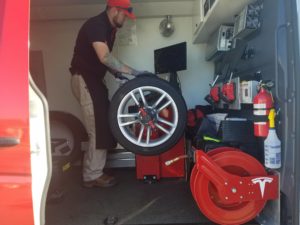Quick and Professional Mobile Tire Repair Las Vegas Providers
Quick and Professional Mobile Tire Repair Las Vegas Providers
Blog Article
Tire Solution: Proven Methods for Ideal Tire Upkeep and Treatment
Preserving optimum tire problem is vital for both safety and security and efficiency of any vehicle. From guaranteeing proper tire pressure to regular rotation and placement, there are tried and tested techniques that can significantly prolong the life-span of your tires and enhance general driving experience. As we check out the intricacies of tire care and upkeep, we will reveal essential standards that every vehicle proprietor need to stick to for the very best possible results. Let's explore the globe of tire service and uncover the secrets to maintaining your tires in top-notch form for the lengthy haul.
Significance of Tire Stress
Appropriate tire pressure is a crucial element in guaranteeing optimum vehicle performance and safety when traveling. Keeping the recommended tire stress levels offered by the manufacturer supplies many benefits. Appropriate tire stress promotes better gas effectiveness, as under-inflated tires can lead to increased rolling resistance, triggering the engine to work more difficult and eat even more gas. Secondly, correct tire pressure makes certain even walk wear, boosting tire long life and conserving cash over time by postponing the requirement for premature replacements. Additionally, appropriately inflated tires add to enhanced handling and stopping capacities, critical for risk-free driving in numerous road problems. Over-inflated tires, on the other hand, can lead to minimized traction and a harsher adventure. Conversely, under-inflated tires are vulnerable to getting too hot, which can result in blowouts and mishaps. Regularly checking and changing tire stress, especially eventually trips, is a simple yet efficient means to boost vehicle efficiency, prolong tire life-span, and focus on security when driving.
Tire Turning Guidelines
When thinking about tire rotation standards, it is vital to understand the importance of this maintenance job in maximizing tire life expectancy and maintaining ideal car performance. Tire turning involves altering the position of each tire on an automobile to make sure also tread wear. Front tires have a tendency to use more rapidly than rear tires due to guiding pressures, making normal rotation important for well balanced wear patterns.

Benefits of Wheel Alignment
Ensuring proper wheel alignment after tire turning is vital for maintaining balanced wear patterns and taking full advantage of car efficiency. Furthermore, proper wheel alignment assists to expand the life expectancy of your tires. Misaligned wheels can trigger irregular tire wear, leading to premature tire replacement and increased upkeep costs.

Tire Tread Depth Inspect
Executing a routine assessment of tire step deepness is essential for preserving safe driving conditions and prolonging the life-span of your tires. The walk on your tires plays a critical function in giving grip, especially in check here unsafe or wet problems. To inspect your tire tread deepness, you can use a walk depth scale or the dime test. The suggested step deepness goes to least 2/32 of an inch. It is time to replace your tires to make certain optimal performance and safety on the roadway if the tread deepness is below this limit. Irregular walk wear can show issues with tire suspension, pressure, or placement, highlighting the importance of normal tread deepness checks. Neglecting to monitor and maintain appropriate tread depth can lead to lowered grip, longer braking distances, and an increased risk of hydroplaning. By incorporating tire step depth check out your regular upkeep routine, you can drive with self-confidence knowing that your tires remain in top condition.
Seasonal Tire Evaluation
Seasonal tire inspection is a fundamental aspect of tire maintenance that makes certain tires are prepared to face the obstacles presented by different weather conditions. site link In prep work for winter, it is crucial to inspect the tire pressure frequently as cold temperature levels can trigger tire stress to drop. By performing regular seasonal tire evaluations, vehicle drivers can prolong tire life-span, boost fuel performance, and most notably, guarantee a safe driving experience in varying weather condition conditions.
Final Thought
Finally, preserving appropriate tire stress, revolving tires frequently, lining up wheels appropriately, checking tread deepness, and performing seasonal inspections are necessary methods for ideal tire care. By following these proven approaches, vehicle drivers can guarantee their tires last longer, carry out better, and add to total car safety. It is important to focus on tire upkeep to stop crashes, boost gas performance, and prolong the lifespan of tires.
Appropriate tire stress promotes better gas effectiveness, as under-inflated tires can lead to boosted rolling resistance, creating the engine to work more challenging and consume even more fuel.When thinking about tire rotation guidelines, it is important to understand the significance of this upkeep job in making best use of tire lifespan and preserving optimal automobile efficiency. Seasonal tire evaluation is a basic aspect of tire upkeep that makes sure tires are all set to face the challenges read more postured by various weather condition problems. By performing regular seasonal tire assessments, vehicle drivers can lengthen tire lifespan, enhance gas effectiveness, and most importantly, ensure a secure driving experience in varying weather problems.
In final thought, keeping correct tire stress, revolving tires on a regular basis, lining up wheels appropriately, keeping track of step depth, and performing seasonal inspections are important practices for optimum tire treatment.
Report this page